 Despite having many of the same culinary resources and origins as neighbouring Thailand, the people of Laos subside on a markedly more basic diet. Considering Laos's poverty and lack of both infrastructure and large-scale agriculture, this shouldn't come as much of a surprise. But the monotony of the rural Lao diet can come as a shock if you've never encountered it personally. This post describes another blogger's nine days of very basic meals in a particularly remote corner of northern Laos. I spent six days in the country on my most recent trip, only four of which were spent in the boondocks of central Laos, but I'd say we had a somewhat similar experience.
Despite having many of the same culinary resources and origins as neighbouring Thailand, the people of Laos subside on a markedly more basic diet. Considering Laos's poverty and lack of both infrastructure and large-scale agriculture, this shouldn't come as much of a surprise. But the monotony of the rural Lao diet can come as a shock if you've never encountered it personally. This post describes another blogger's nine days of very basic meals in a particularly remote corner of northern Laos. I spent six days in the country on my most recent trip, only four of which were spent in the boondocks of central Laos, but I'd say we had a somewhat similar experience.
All of our meals were based around sticky rice. At a couple dinners this staple was accompanied by dishes such as sour soups with frog or fish, grilled chicken, and on one occasion, bamboo shoot soup (kaeng nor mai). Otherwise we ate sticky rice with tinned fish and a grilled chili dip, sticky rice with tiny grilled fish or chicken and a grilled chili dip, or instant noodles. None of it (other than the instant noodles) was bad, but it was pretty monotonous, and given the almost blanket absence of vegetables, not entirely nutritious. Yet despite this, I suspect that our meals had significantly more variety and nutrition than those of the people hosting us.
A notable exception to this diet came the day we explored Tham Lot Se Bang Fai, a 6.5km-long cave created by the flow of the Se Bang Fai. While we were busy inside the cave, a few of the villagers of Ban Nong Ping, our host village, had gathered the baby swifts and bats that had fallen to the cave floor or in the water. These were boiled and plucked:
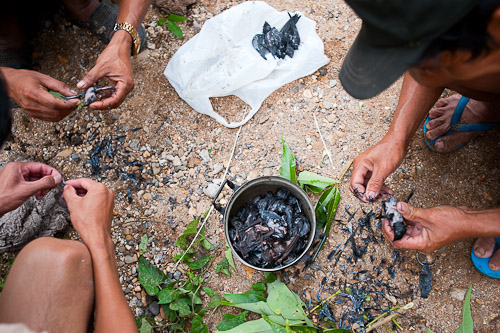
and like most of our meals, were grilled:
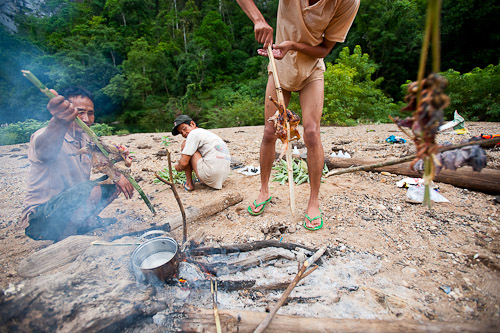
And as if eating scavenged baby birds and bats wasn't enough, the villagers had a particular way of preparing them that made already questionable (by our standards, at least) food even worse. Basically they charred the bats and birds, grilling them until they were unrecogniseable black shells. I suspect that this makes the bones, wings and skin easier to eat:
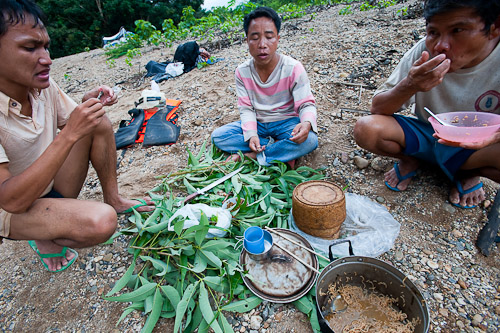
Luckily for us, the bats and birds were a special treat for the people who'd gathered them, and our meal was the reassuringly monotonous mix of grilled chicken, instant noodles, sticky rice and a grilled chili dip.













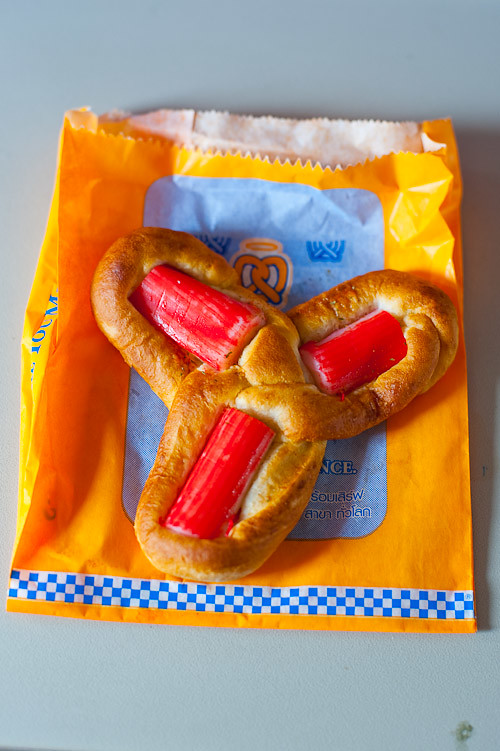 A three-pronged Auntie Anne's pretzel topped with hearty sticks of imitation crab. Encountered on a Nok Air flight from Bangkok to Nakhon Phanom. Resemblance to airplane propeller moderate, but edibility negligible.
A three-pronged Auntie Anne's pretzel topped with hearty sticks of imitation crab. Encountered on a Nok Air flight from Bangkok to Nakhon Phanom. Resemblance to airplane propeller moderate, but edibility negligible. Tanks crossing the barricade into the protesters' camp, Bangkok
Tanks crossing the barricade into the protesters' camp, Bangkok As mentioned
As mentioned 

 Damage and burning along Rama IV, Bangkok
Damage and burning along Rama IV, Bangkok I live just off of Thanon Silom, which in addition to being the area of Bangkok with arguably the most restaurants and street food, is also directly adjacent to the epicentre of
I live just off of Thanon Silom, which in addition to being the area of Bangkok with arguably the most restaurants and street food, is also directly adjacent to the epicentre of 

 Government soldier looks for snipers on Thanon Rama IV, Bangkok
Government soldier looks for snipers on Thanon Rama IV, Bangkok  Anti-government 'red shirt' protesters taunt soldiers, Rama IV, Bangkok
Anti-government 'red shirt' protesters taunt soldiers, Rama IV, Bangkok Locals cautiously watching the conflict unfolding on Rama IV, Bangkok
Locals cautiously watching the conflict unfolding on Rama IV, Bangkok Red shirt protesters stand their ground on Rama IV, Bangkok
Red shirt protesters stand their ground on Rama IV, Bangkok Red shirt protesters taunt soldiers, Rama IV, Bangkok
Red shirt protesters taunt soldiers, Rama IV, Bangkok Soldiers prepare to fire on red shirt protesters, Rama IV, Bangkok
Soldiers prepare to fire on red shirt protesters, Rama IV, Bangkok Red shirt protesters taunt soldiers on Thanon Rama IV
Red shirt protesters taunt soldiers on Thanon Rama IV  A violent confrontation between red shirt protesters and government soldiers along Rama IV
A violent confrontation between red shirt protesters and government soldiers along Rama IV  Soldiers preparing to fire at red shirt protesters on Thanon Rama IV
Soldiers preparing to fire at red shirt protesters on Thanon Rama IV  Soldiers firing an alleged mixture of rubber bullets, blanks and real bullets at protesters, Thanon Rama IV
Soldiers firing an alleged mixture of rubber bullets, blanks and real bullets at protesters, Thanon Rama IV  Captured red shirt protesters near Lumphini Boxing Statdium, Bangkok
Captured red shirt protesters near Lumphini Boxing Statdium, Bangkok Soldiers unrolling barbed wire along Rama IV, Bangkok. Smoking tires can be seen in the background.
Soldiers unrolling barbed wire along Rama IV, Bangkok. Smoking tires can be seen in the background.
 Locals look at burning tires on a bridge near Thanon Silom
Locals look at burning tires on a bridge near Thanon Silom 










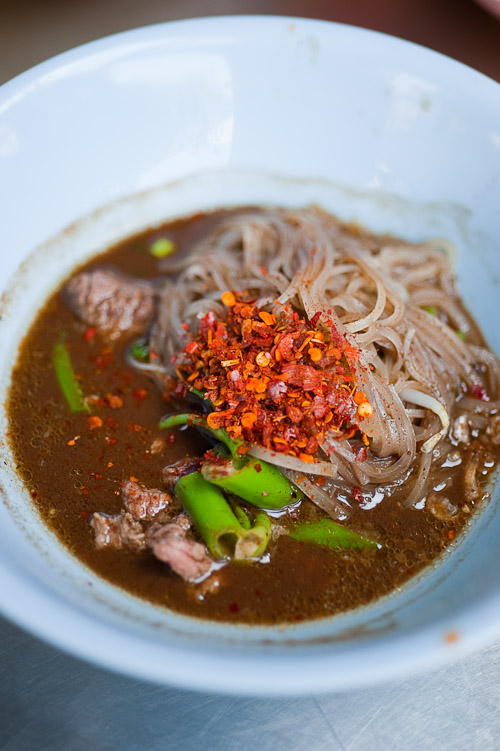 Urai, a boat noodle restaurant in Ayuthaya's Sena District, is part of a government-funded scheme called Thong Fah ('Blue Flag') that has established exceedingly cheap restaurants, often serving regional dishes, around the country (
Urai, a boat noodle restaurant in Ayuthaya's Sena District, is part of a government-funded scheme called Thong Fah ('Blue Flag') that has established exceedingly cheap restaurants, often serving regional dishes, around the country (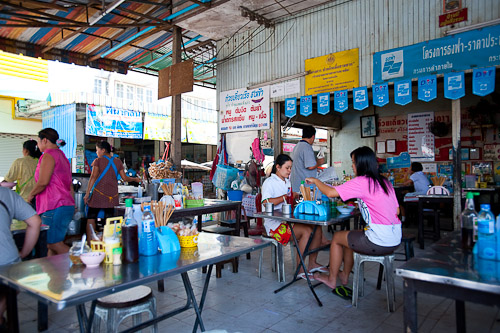
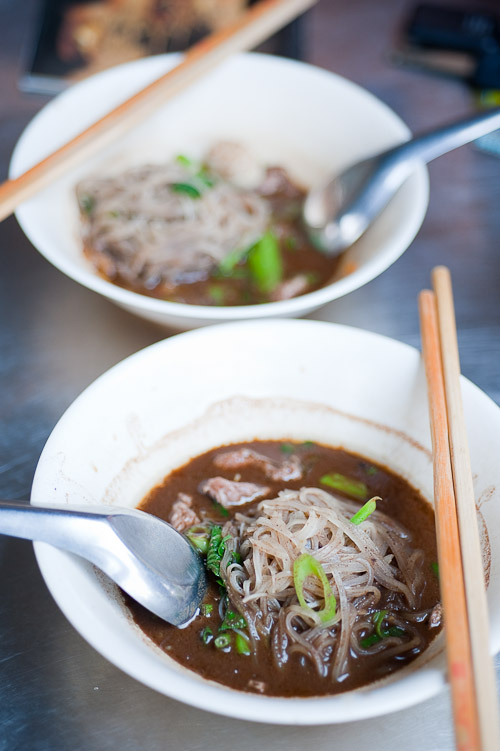
 I'm finally back home after about two months in Laos, and yet again, am craving odd Thai dishes. This time it's kuaytiaw reua (boat noodles), so naturally I headed to the heartland of the dish (and possibly one of the more underrated food cities in Thailand), Ayuthaya.
I'm finally back home after about two months in Laos, and yet again, am craving odd Thai dishes. This time it's kuaytiaw reua (boat noodles), so naturally I headed to the heartland of the dish (and possibly one of the more underrated food cities in Thailand), Ayuthaya.
 It wasn't all sticky rice and grilled meat for the last couple months. Setting out on a road trip to central Laos with my trusty driver Christophe (above, on the left), I picked up a grab bag of French goodies at Les Boutiques Scoubidou, Vientiane's best French deli:
It wasn't all sticky rice and grilled meat for the last couple months. Setting out on a road trip to central Laos with my trusty driver Christophe (above, on the left), I picked up a grab bag of French goodies at Les Boutiques Scoubidou, Vientiane's best French deli:

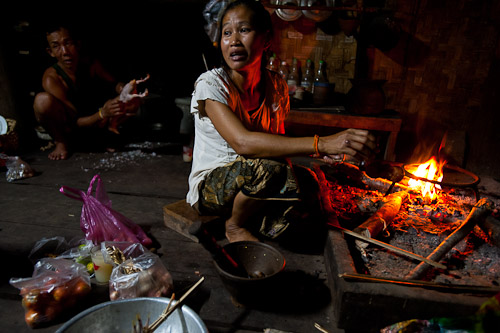 More and more communities in rural Laos are opening up their doors to foreign visitors in the form of homestays. Ban Hat Khai, a village located at the edge of
More and more communities in rural Laos are opening up their doors to foreign visitors in the form of homestays. Ban Hat Khai, a village located at the edge of 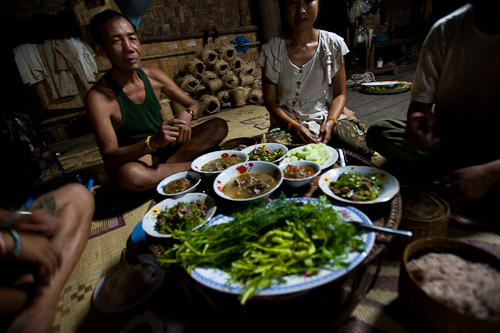
 Boat driver on the Nam Kading River, Laos
Boat driver on the Nam Kading River, Laos If you spend enough time on Rte 8, the Lao highway corridor linking Thailand and Vietnam, you’re bound to encounter huge lorries bound for Vietnam carrying cages filled with hundreds of dogs.
If you spend enough time on Rte 8, the Lao highway corridor linking Thailand and Vietnam, you’re bound to encounter huge lorries bound for Vietnam carrying cages filled with hundreds of dogs.
 After more than a month in Vientiane, I have to admit that it's still the case that I've still only been able to find a scant handful of places that do good Lao food. Luckily I live literally around the corner from one that I, not to mention many locals, consider the best place in town.
After more than a month in Vientiane, I have to admit that it's still the case that I've still only been able to find a scant handful of places that do good Lao food. Luckily I live literally around the corner from one that I, not to mention many locals, consider the best place in town.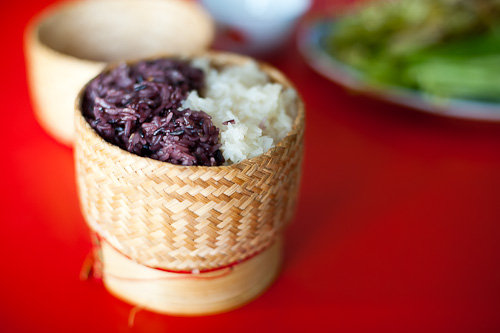





 Watching a pétanque game
Watching a pétanque game Moving back in time slightly, while home a couple weeks ago I also had my first chance to cook in a month: I made cozido à Portuguesa from
Moving back in time slightly, while home a couple weeks ago I also had my first chance to cook in a month: I made cozido à Portuguesa from  Actually this photo could have been taken just about anywhere in Laos; it illustrates a typical scenario that unfolds upon pulling into any rural bus station here. Even before the bus comes to a complete stop, women frantically run to the bus waving sticks of grilled chicken, bags of sticky rice or mangoes, grilled eggs, buckets of drinks and tubes of nyaa dom (nasal inhalers). I don't tend to see too many purchases, but the number of vendors suggests it must be at least a somewhat profitable venture.
Actually this photo could have been taken just about anywhere in Laos; it illustrates a typical scenario that unfolds upon pulling into any rural bus station here. Even before the bus comes to a complete stop, women frantically run to the bus waving sticks of grilled chicken, bags of sticky rice or mangoes, grilled eggs, buckets of drinks and tubes of nyaa dom (nasal inhalers). I don't tend to see too many purchases, but the number of vendors suggests it must be at least a somewhat profitable venture. Am back in Vientiane after an all-too-brief visit to Bangkok followed by a week in the central Lao province of Savannakhet. And what a week it's been... My job at the moment is essentially to walk around towns in Laos and gather information, a task that's been made increasingly difficult by the arrival of summer here in Southeast Asia. Although I've lived in the region for over a decade now, I've only spent a couple summers here, typically having spent this time of year at home in Oregon or Sweden, or somewhere else cool. As a result, the intense heat feels relatively new to me, and is almost unbearable, particularly for one who's walking as much as 10km or more a day. I honestly don't think I've ever sweated so much in my life, but rehydrating in Savannkhet was a literal pleasure, thanks to
Am back in Vientiane after an all-too-brief visit to Bangkok followed by a week in the central Lao province of Savannakhet. And what a week it's been... My job at the moment is essentially to walk around towns in Laos and gather information, a task that's been made increasingly difficult by the arrival of summer here in Southeast Asia. Although I've lived in the region for over a decade now, I've only spent a couple summers here, typically having spent this time of year at home in Oregon or Sweden, or somewhere else cool. As a result, the intense heat feels relatively new to me, and is almost unbearable, particularly for one who's walking as much as 10km or more a day. I honestly don't think I've ever sweated so much in my life, but rehydrating in Savannkhet was a literal pleasure, thanks to 

